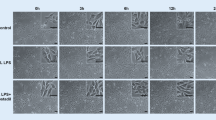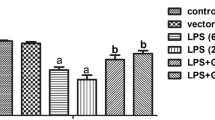Abstract
Upregulation of urokinase plasminogen activator (uPA), tissue plasminogen activator (tPA), and matrix metallopeptidases (MMPs) is associated with the development of myocardial infarction (MI), dilated cardiomyopathy, cardiac fibrosis, and heart failure (HF). Evidences suggest that lipopolysaccharide (LPS) participates in the inflammatory response in the cardiovascular system; however, it is unknown if LPS is sufficient to upregulate expressions and/or activity of uPA, tPA, MMP-2, and MMP-9 in myocardial cells. In this study, we treated H9c2 cardiomyoblasts with LPS to explore whether LPS upregulates uPA, tPA, MMP-2, and MMP-9, and further to identify the precise molecular and cellular mechanisms behind this upregulatory responses. Here, we show that LPS challenge increased the protein levels of uPA, MMP-2 and MMP-9, and induced the activity of MMP-2 and MMP-9 in H9c2 cardiomyoblasts. However, LPS showed no effects on the expression of tissue inhibitor of metalloproteinase-1, -2, -3, and -4 (TIMP-1, -2, -3, and -4). After administration of inhibitors including U0126 (ERK1/2 inhibitor), SB203580 (p38 MAPK inhibitor), SP600125 (JNK1/2 inhibitor), CsA (calcineurin inhibitor), and QNZ (NFκB inhibitor), the LPS-upregulated expression and/or activity of uPA, MMP-2, and MMP-9 in H9c2 cardiomyoblasts are markedly inhibited only by ERK1/2 inhibitors, U0126. Collectively, these results suggest that LPS upregulates the expression and/or activity of uPA, MMP-2, and MMP-9 through ERK1/2 signaling pathway in H9c2 cardiomyoblasts. Our findings further provide a link between the LPS-induced cardiac dysfunction and the ERK1/2 signaling pathway that mediates the upregulation of uPA, MMP-2 and MMP-9.






Similar content being viewed by others
Abbreviations
- LPS:
-
Lipopolysacchride
- TLR:
-
Toll-like receptor
- ERK:
-
Extracellular signal regulated kinase
- p38 MAPK:
-
p38 Mitogen-activated protein kinase
- JNK:
-
c-Jun N-terminal kinase
- NF-κB:
-
Nuclear factor κ B
- uPA:
-
Urokinase plasminogen activator
- tPA:
-
Tissue plasminogen activator
- MMP:
-
Matrix metallopeptidase
- TIMP:
-
Tissue inhibitor of metalloproteinases
- CsA:
-
Cyclosporine A
- DMEM:
-
Dulbecco’s modified Eagle’s medium
- GAPDH:
-
Glyceraldehyde-3-phosphate dehydrogenase
- PBS:
-
Phosphate-buffered saline
- QNZ:
-
6-Amino-4-(4-phenoxyphenylethylamino) quinazoline
- ECM:
-
Extracellular matrix
References
Coussens LM, Fingleton B, Matrisian LM (2002) Matrix metalloproteinase inhibitors and cancer: trials and tribulations. Science 295:2387–2392. doi:10.1126/science.1067100
Ellerbroek SM, Stack MS (1999) Membrane associated matrix metalloproteinases in metastasis. Bioessays 21:940–949 doi:10.1002/(SICI)1521-1878(199911)21:11<940::AID-BIES6>3.0.CO;2-J
Peterson JT, Li H, Dillon L et al (2000) Evolution of matrix metalloprotease and tissue inhibitor expression during heart failure progression in the infarcted rat. Cardiovasc Res 46:307–315. doi:10.1016/S0008-6363(00)00029-8
Heymans S, Luttun A, Nuyens D et al (1999) Inhibition of plasminogen activators or matrix metalloproteinases prevents cardiac rupture but impairs therapeutic angiogenesis and causes cardiac failure. Nat Med 5:1135–1142. doi:10.1038/13459
Ducharme A, Frantz S, Aikawa M et al (2000) Targeted deletion of matrix metalloproteinase-9 attenuates left ventricular enlargement and collagen accumulation after experimental myocardial infarction. J Clin Invest 106:55–62. doi:10.1172/JCI8768
Hayashidani S, Tsutsui H, Ikeuchi M et al (2003) Targeted deletion of MMP-2 attenuates early LV rupture and late remodeling after experimental myocardial infarction. Am J Physiol Heart Circ Physiol 285:H1229–H1235
Li YY, McTiernan CF, Feldman AM (2000) Interplay of matrix metalloproteinases, tissue inhibitors of metalloproteinases and their regulators in cardiac matrix remodeling. Cardiovasc Res 46:214–224. doi:10.1016/S0008-6363(00)00003-1
Creemers E, Cleutjens J, Smits J et al (2000) Disruption of the plasminogen gene in mice abolishes wound healing after myocardial infarction. Am J Pathol 156:1865–1873
Heymans S, Lupu F, Terclavers S et al (2005) Loss or inhibition of uPA or MMP-9 attenuates LV remodeling and dysfunction after acute pressure overload in mice. Am J Pathol 166:15–25
Bishopric NH, Andreka P, Slepak T et al (2001) Molecular mechanisms of apoptosis in the cardiac myocyte. Curr Opin Pharmacol 1:141–150. doi:10.1016/S1471-4892(01)00032-7
Sugden PH, Clerk A (1998) “Stress-responsive” mitogen-activated protein kinases (c-Jun N-terminal kinases and p38 mitogen-activated protein kinases) in the myocardium. Circ Res 83:345–352
Zhu W, Zou Y, Aikawa R et al (1999) MAPK superfamily plays an important role in daunomycin-induced apoptosis of cardiac myocytes. Circulation 100:2100–2107
Dhingra S, Sharma AK, Singla DK et al (2007) p38 and ERK1/2 MAPKs mediate the interplay of TNF-alpha and IL-10 in regulating oxidative stress and cardiac myocyte apoptosis. Am J Physiol Heart Circ Physiol 293:H3524–H3531. doi:10.1152/ajpheart.00919.2007
Wang M, Sankula R, Tsai BM et al (2004) P38 MAPK mediates myocardial proinflammatory cytokine production and endotoxin-induced contractile suppression. Shock 21:170–174. doi:10.1097/01.shk.0000110623.20647.aa
Meldrum DR, Dinarello CA, Cleveland JC et al (1998) Hydrogen peroxide induces tumor necrosis factor alpha-mediated cardiac injury by a P38 mitogen-activated protein kinase-dependent mechanism. Surgery 124:291–296 (discussion 297)
Dougherty CJ, Kubasiak LA, Prentice H et al (2002) Activation of c-Jun N-terminal kinase promotes survival of cardiac myocytes after oxidative stress. Biochem J 362:561–571. doi:10.1042/0264-6021:3620561
Minamino T, Yujiri T, Terada N et al (2002) MEKK1 is essential for cardiac hypertrophy and dysfunction induced by Gq. Proc Natl Acad Sci USA 99:3866–3871. doi:10.1073/pnas.062453699
Boyd JH, Mathur S, Wang Y et al (2006) Toll-like receptor stimulation in cardiomyoctes decreases contractility and initiates an NF-kappaB dependent inflammatory response. Cardiovasc Res 72:384–393. doi:10.1016/j.cardiores.2006.09.011
Wilkins BJ, Molkentin JD (2002) Calcineurin and cardiac hypertrophy: where have we been? Where are we going? J Physiol 541:1–8. doi:10.1113/jphysiol.2002.017129
Lakshmikuttyamma A, Selvakumar P, Kakkar R et al (2003) Activation of calcineurin expression in ischemia-reperfused rat heart and in human ischemic myocardium. J Cell Biochem 90:987–997. doi:10.1002/jcb.10722
Molkentin JD, Lu JR, Antos CL et al (1998) A calcineurin-dependent transcriptional pathway for cardiac hypertrophy. Cell 93:215–228. doi:10.1016/S0092-8674(00)81573-1
Yang RB, Mark MR, Gray A et al (1998) Toll-like receptor-2 mediates lipopolysaccharide-induced cellular signalling. Nature 395:284–288. doi:10.1038/26239
Stoll LL, Denning GM, Weintraub NL (2004) Potential role of endotoxin as a proinflammatory mediator of atherosclerosis. Arterioscler Thromb Vasc Biol 24:2227–2236. doi:10.1161/01.ATV.0000147534.69062.dc
Niebauer J, Volk HD, Kemp M et al (1999) Endotoxin and immune activation in chronic heart failure: a prospective cohort study. Lancet 353:1838–1842. doi:10.1016/S0140-6736(98)09286-1
Jardin F, Brun-Ney D, Auvert B et al (1990) Sepsis-related cardiogenic shock. Crit Care Med 18:1055–1060. doi:10.1097/00003246-199010000-00001
Packer M (1995) Is tumor necrosis factor an important neurohormonal mechanism in chronic heart failure? Circulation 92:1379–1382
Yasuda S, Lew WY (1997) Lipopolysaccharide depresses cardiac contractility and beta-adrenergic contractile response by decreasing myofilament response to Ca2+ in cardiac myocytes. Circ Res 81:1011–1020
Mann DL, Spinale FG (1998) Activation of matrix metalloproteinases in the failing human heart: breaking the tie that binds. Circulation 98:1699–1702
Gunja-Smith Z, Morales AR, Romanelli R et al (1996) Remodeling of human myocardial collagen in idiopathic dilated cardiomyopathy. Role of metalloproteinases and pyridinoline cross-links. Am J Pathol 148:1639–1648
Tyagi SC (1997) Proteinases and myocardial extracellular matrix turnover. Mol Cell Biochem 168:1–12. doi:10.1023/A:1006850903242
Tyagi SC, Kumar SG, Alla SR et al (1996) Extracellular matrix regulation of metalloproteinase and antiproteinase in human heart fibroblast cells. J Cell Physiol 167:137–147 doi:10.1002/(SICI)1097-4652(199604)167:1<137::AID-JCP16>3.0.CO;2-8
Li H, Simon H, Bocan TM et al (2000) MMP/TIMP expression in spontaneously hypertensive heart failure rats: the effect of ACE- and MMP-inhibition. Cardiovasc Res 46:298–306. doi:10.1016/S0008-6363(00)00028-6
Li YY, Feng YQ, Kadokami T et al (2000) Myocardial extracellular matrix remodeling in transgenic mice overexpressing tumor necrosis factor alpha can be modulated by anti-tumor necrosis factor alpha therapy. Proc Natl Acad Sci USA 97:12746–12751. doi:10.1073/pnas.97.23.12746
Kubota T, McTiernan CF, Frye CS et al (1997) Dilated cardiomyopathy in transgenic mice with cardiac-specific overexpression of tumor necrosis factor-alpha. Circ Res 81:627–635
Goldberg GI, Marmer BL, Grant GA et al (1989) Human 72-kilodalton type IV collagenase forms a complex with a tissue inhibitor of metalloproteases designated TIMP-2. Proc Natl Acad Sci USA 86:8207–8211. doi:10.1073/pnas.86.21.8207
Roten L, Nemoto S, Simsic J et al (2000) Effects of gene deletion of the tissue inhibitor of the matrix metalloproteinase-type 1 (TIMP-1) on left ventricular geometry and function in mice. J Mol Cell Cardiol 32:109–120. doi:10.1006/jmcc.1999.1052
Creemers EE, Davis JN, Parkhurst AM et al (2003) Deficiency of TIMP-1 exacerbates LV remodeling after myocardial infarction in mice. Am J Physiol Heart Circ Physiol 284:H364–H371
Mukherjee R, Parkhurst AM, Mingoia JT et al (2004) Myocardial remodeling after discrete radiofrequency injury: effects of tissue inhibitor of matrix metalloproteinase-1 gene deletion. Am J Physiol Heart Circ Physiol 286:H1242–H1247. doi:10.1152/ajpheart.00437.2003
Fedak PW, Smookler DS, Kassiri Z et al (2004) TIMP-3 deficiency leads to dilated cardiomyopathy. Circulation 110:2401–2409. doi:10.1161/01.CIR.0000134959.83967.2D
Wagner DR, Combes A, McTiernan C et al (1998) Adenosine inhibits lipopolysaccharide-induced cardiac expression of tumor necrosis factor-alpha. Circ Res 82:47–56
Blum A, Sclarovsky S, Rehavia E, Shohat B (1994) Levels of T-lymphocyte subpopulations, interleukin-1 beta, and soluble interleukin-2 receptor in acute myocardial infarction. Am Heart J 127:1226–1230. doi:10.1016/0002-8703(94)90040-X
Anker SD, von Haehling S (2004) Inflammatory mediators in chronic heart failure: an overview. Heart 90:464–470. doi:10.1136/hrt.2002.007005
Rauchhaus M, Doehner W, Francis DP et al (2000) Plasma cytokine parameters and mortality in patients with chronic heart failure. Circulation 102:3060–3067
Kumar A, Haery C, Parrillo JE (2000) Myocardial dysfunction in septic shock. Crit Care Clin 16:251–287. doi:10.1016/S0749-0704(05)70110-X
Kumar A, Brar R, Wang P et al (1999) Role of nitric oxide and cGMP in human septic serum-induced depression of cardiac myocyte contractility. Am J Physiol 276:R265–R276
Medzhitov R, Preston-Hurlburt P, Janeway CA (1997) A human homologue of the Drosophila Toll protein signals activation of adaptive immunity. Nature 388:394–397. doi:10.1038/41131
Methe H, Kim JO, Kofler S et al (2005) Expansion of circulating Toll-like receptor 4-positive monocytes in patients with acute coronary syndrome. Circulation 111:2654–2661. doi:10.1161/CIRCULATIONAHA.104.498865
Liu CJ, Cheng YC, Lee KW et al (2008) Lipopolysaccharide induces cellular hypertrophy through calcineurin/NFAT-3 signaling pathway in H9c2 myocardiac cells. Mol Cell Biochem 313:167–178. doi:10.1007/s11010-008-9754-0
Baumgarten G, Knuefermann P, Nozaki N et al (2001) In vivo expression of proinflammatory mediators in the adult heart after endotoxin administration: the role of toll-like receptor-4. J Infect Dis 183:1617–1624. doi:10.1086/320712
Li C, Ha T, Kelley J et al (2004) Modulating Toll-like receptor mediated signaling by (1–3)-beta-D-glucan rapidly induces cardioprotection. Cardiovasc Res 61:538–547. doi:10.1016/j.cardiores.2003.09.007
Ravingerova T, Barancik M, Strniskova M (2003) Mitogen-activated protein kinases: a new therapeutic target in cardiac pathology. Mol Cell Biochem 247:127–138. doi:10.1023/A:1024119224033
Baines CP, Molkentin JD (2005) STRESS signaling pathways that modulate cardiac myocyte apoptosis. J Mol Cell Cardiol 38:47–62. doi:10.1016/j.yjmcc.2004.11.004
Author information
Authors and Affiliations
Corresponding author
Additional information
Wei-Wen Kuo, Chih-Yang Huang and Chung-Jung Liu contributed equally to this article.
Rights and permissions
About this article
Cite this article
Cheng, YC., Chen, LM., Chang, MH. et al. Lipopolysaccharide upregulates uPA, MMP-2 and MMP-9 via ERK1/2 signaling in H9c2 cardiomyoblast cells. Mol Cell Biochem 325, 15–23 (2009). https://doi.org/10.1007/s11010-008-0016-y
Received:
Accepted:
Published:
Issue Date:
DOI: https://doi.org/10.1007/s11010-008-0016-y




